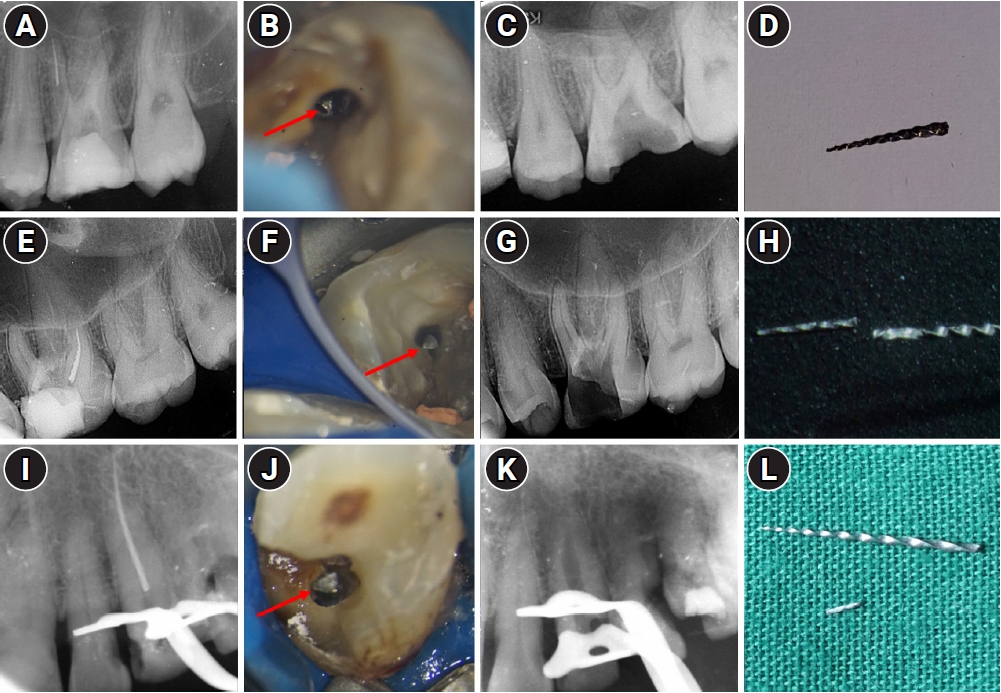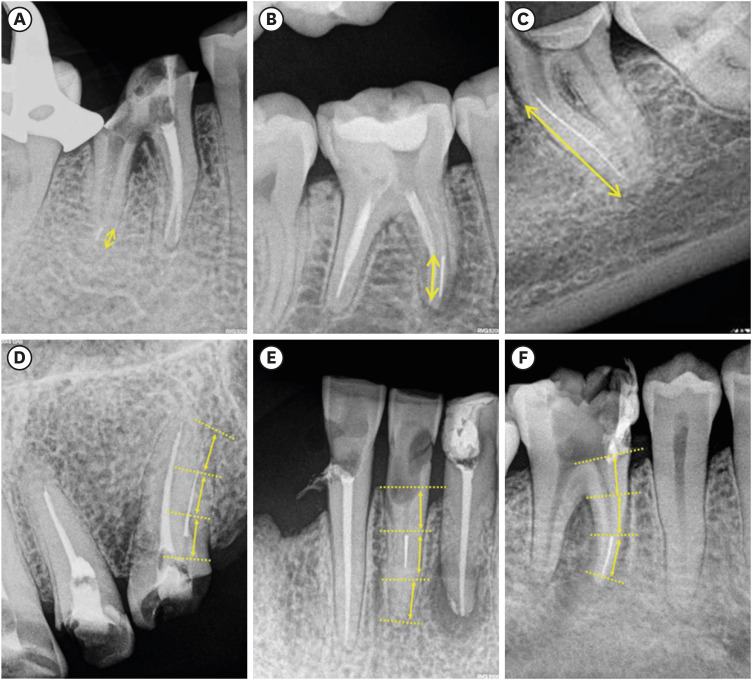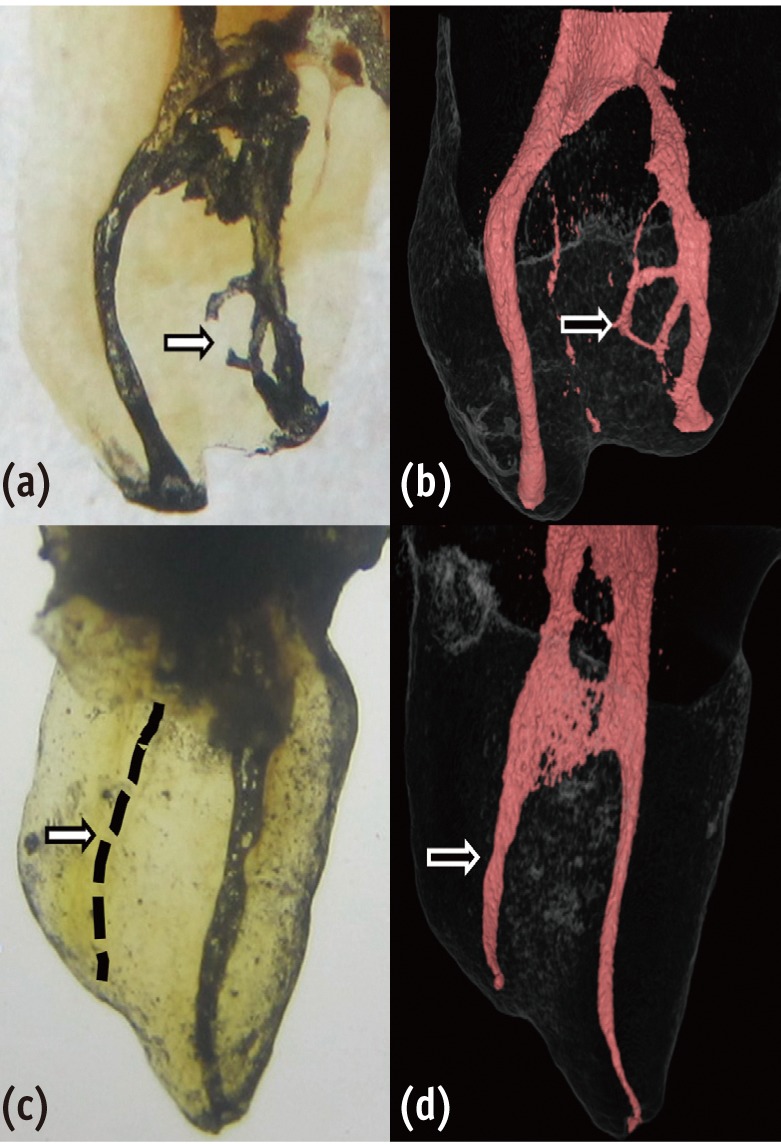Search
- Page Path
- HOME > Search
- Pattern of endodontic instrument separation and factors affecting its retrieval: a 10-year retrospective observational study in a postgraduate institute
- Velmurugan Natanasabapathy, Aswathi Varghese, Paul Kevin Abishek Karthikeyan, Srinivasan Narasimhan
- Restor Dent Endod 2025;50(1):e7. Published online February 19, 2025
- DOI: https://doi.org/10.5395/rde.2025.50.e7

-
 Abstract
Abstract
 PDF
PDF PubReader
PubReader ePub
ePub - Objectives
This study aimed to assess the pattern of endodontic instrument separation, their retrievability, and factors affecting its retrieval, in a postgraduate institute.
Methods
Cases referred for the management of separated endodontic instruments (SEI) from 2013 to 2023 were considered for this study. Data related to demographics, tooth type, file type, and retrieval were documented in an Excel sheet. Eight prognostic factors assumed to influence the retrieval were analyzed in this study. The secondary aim was to compare the pattern of SEI and retrievability between conventional nickel-titanium files and newer generation heat-treated nickel-titanium files. Retrieval was attempted by a senior endodontist under the dental operating microscope. Various ultrasonic tips and a Broken Tool Removal loop system were used during retrieval. Simple descriptive statistics were performed. Binomial logistic regression was done to identify the effect of the eight prognostic factors on the retrieval outcome.
Results
A total of 190 SEI was reported. SEI occurred more often in posterior teeth than anterior teeth, mandibular arch than maxillary arch, and in larger files than smaller files. Separation occurred more often in the apical third compared to the other levels. Retrieval was attempted in 88 cases and successful in 70 cases (79.5%). The larger taper and apical position of the SEI negatively influenced the retrieval by 1.4 and 8.7 times, respectively.
Conclusions
Retrieval of SEI was successful in the majority of the cases. An increase in taper and apically placed SEI negatively impacted the retrieval. There was no difference in the pattern of separation nor retrievability between conventional nickel-titanium files and newer generation heat-treated nickel-titanium files.
- 607 View
- 65 Download

- Predictive factors in the retrieval of endodontic instruments: the relationship between the fragment length and location
- Ricardo Portigliatti, Eugenia Pilar Consoli Lizzi, Pablo Alejandro Rodríguez
- Restor Dent Endod 2024;49(4):e35. Published online September 9, 2024
- DOI: https://doi.org/10.5395/rde.2024.49.e35

-
 Abstract
Abstract
 PDF
PDF PubReader
PubReader ePub
ePub Objectives This study aimed to relate the file fragment length and location in the root canal to the retrieval chances, the clinical time required and the occurrence of secondary fractures.
Materials and Methods Sixty clinical cases of fractured instruments were included in this study. They were classified according to the instrument length and the location of the root canal. In each group, the success rate in the instrument retrieval, the clinical time required and the occurrence of secondary fractures were evaluated. The collected data were analyzed using the Kruskal-Wallis test on the basis of a 0.05 significance level.
Results The fragment length showed no significant influence on the assessed variables (
p > 0.05). The root third where the instrument was located resulted in an increased clinical time, with statistically significant differences (p < 0.05). However, the procedure success rate and the occurrence of secondary fractures showed no association with these variables.Conclusions In accordance with the findings of this study, the fractured fragment length did not influence any of the variables assessed, but it is suggested to focus on the fragment location inside the root canal to decide the retrieval of a fractured instrument.
-
Citations
Citations to this article as recorded by- Neodymium-Doped Yttrium Aluminum Perovskite (Nd:YAP) Laser in the Elimination of Endodontic Nickel-Titanium Files Fractured in Rooted Canals (Part 2: Teeth With Significant Root Curvature)
Amaury Namour, Marwan El Mobadder, Clément Cerfontaine, Patrick Matamba, Lucia Misoaga, Delphine Magnin , Praveen Arany, Samir Nammour
Cureus.2025;[Epub] CrossRef
- Neodymium-Doped Yttrium Aluminum Perovskite (Nd:YAP) Laser in the Elimination of Endodontic Nickel-Titanium Files Fractured in Rooted Canals (Part 2: Teeth With Significant Root Curvature)
- 617 View
- 104 Download
- 1 Crossref

- Retrieval of a separated nickel-titanium instrument using a modified 18-guage needle and cyanoacrylate glue: a case report
- Syed Mukhtar-Un-Nisar Andrabi, Ashok Kumar, Huma Iftekhar, Sharique Alam
- Restor Dent Endod 2013;38(2):93-97. Published online May 28, 2013
- DOI: https://doi.org/10.5395/rde.2013.38.2.93

-
 Abstract
Abstract
 PDF
PDF PubReader
PubReader ePub
ePub During root canal preparation procedures, the potential for instrument breakage is always present. When instrument breakage occurs, it leads to anxiety of the clinician and as well as a metallic obstruction of the canal which hinders further cleaning and shaping. Separated instruments must always be attempted for retrieval and if retrieval is not possible bypass should be tried. With the increased use of nickel-titanium (NiTi) instruments the incidence of separated instruments has increased. A considerable amount of research has been done to understand the various factors related to the fracture of NiTi instruments to minimize its occurrence. This paper presents a review of the literature regarding the fracture of NiTi instruments and also describes a case report showing the use of a modified 18-guage needle and cyanoacrylate glue to retrieve a separated NiTi instrument from the mesiolingual canal of a mandibular first molar.
-
Citations
Citations to this article as recorded by- Tooth fragment reattachment using cyanoacrylate tissue adhesive and flowable composite: An in vitro study
Gurmeen Kaur, Chitharanjan Shetty, Shalin Ann Saji, Sunheri Bajpe, Chandra Prabha, Rashi Shroff
Endodontology.2024; 36(4): 339. CrossRef - Broken Instrument Removal Methods with a Minireview of the Literature
Mohsen Aminsobhani, Nasim Hashemi, Fatemeh Hamidzadeh, Pegah Sarraf, Giovanni Mergoni
Case Reports in Dentistry.2024;[Epub] CrossRef - Causes and prevention of endodontic file fractures: a review of the literature
Erkal Damla, Er Kürşat
Acta Stomatologica Marisiensis Journal.2024; 7(2): 33. CrossRef - Management of Bilateral Foreign Objects in Immature Permanent Maxillary Central Incisors: A Case Report
Hemant Ramesh Chourasia
European Journal of General Dentistry.2023; 12(03): 209. CrossRef - Removing Fractured Endodontic Files with a Tube Technique—The Strength of the Glued Joint: Tube-Endodontic File Setup
Katarzyna Olczak, Jacek Grabarczyk, Witold Szymański
Materials.2023; 16(11): 4100. CrossRef - The management of separated endodontic instruments using a customized syringe and loop technique: A case series
Raghavendra Penukonda, Harsh Amlani, Harshada Pattar, Galvin Sim Siang Lin
Endodontology.2023; 35(1): 65. CrossRef - Retrieval of Separated Endodontic Instrument and Management of Ellis Class 3 Fracture in Children: A Case Report
Mahesh V Dadpe, Prasanna T Dahake, Sagar D Misal, Yogesh J Kale, Shrikant B Kendre
Journal of Mahatma Gandhi University of Medical Sciences and Technology.2022; 7(1): 18. CrossRef - Tube Technique with Light-curing Composite for Removing Fractured Root Canal Instruments: Influence of Polymerization Cycles and Mechanical Exposure
Marius Brühl, Kent Urban, David Donnermeyer, Edgar Schäfer, Sebastian Bürklein
Journal of Endodontics.2020; 46(3): 425. CrossRef - The top 10 most-cited articles on the management of fractured instruments: a bibliometric analysis
Lora Mishra, Hyeon-Cheol Kim, Naomi Ranjan Singh, Priti Pragati Rath
Restorative Dentistry & Endodontics.2019;[Epub] CrossRef - Removing Fractured Endodontic NiTi Instruments with a Tube Technique: Influence of Pre-Treatment with Various Agents on Adhesive Forces In Vitro
Sebastian Bürklein, David Donnermeyer, Michael Wefelmeier, Edgar Schäfer, Kent Urban
Materials.2019; 13(1): 144. CrossRef - Mechanical Properties of Glide Path Preparation Instruments with Different Pitch Lengths
Dana Al Raeesi, Sang Won Kwak, Jung-Hong Ha, Sameh Sulaiman, Rashid El Abed, Hyeon-Cheol Kim
Journal of Endodontics.2018; 44(5): 864. CrossRef - Removing Fractured Endodontic Instruments with a Modified Tube Technique Using a Light-curing Composite
Michael Wefelmeier, Maria Eveslage, Sebastian Bürklein, Klaus Ott, Markus Kaup
Journal of Endodontics.2015; 41(5): 733. CrossRef - Prevention and management of fractured instruments in endodontic treatment
Wei-Rong Tang
World Journal of Surgical Procedures.2015; 5(1): 82. CrossRef - Management of Fractured Endodontic Instruments In Root Canal: A Review
Rambabu T
Journal of Scientific Dentistry.2014; 4(2): 40. CrossRef - A Method for retrieving Endodontic or Atypical Nonendodontic separated Instruments from the Root Canal: A Report of Two Cases
Renato de Toledo Leonardo, Milton Carlos Kuga, Katia Cristina Keine, Andrea Abi Rached Dantas, Gisele Faria, Jardel Camilo do Carmo Monteiro, Keren Cristina Fagundes Jordão-Basso, Prashant Jay Ruchaya
The Journal of Contemporary Dental Practice.2014; 15(6): 770. CrossRef
- Tooth fragment reattachment using cyanoacrylate tissue adhesive and flowable composite: An in vitro study
- 201 View
- 1 Download
- 15 Crossref


 KACD
KACD

 First
First Prev
Prev


